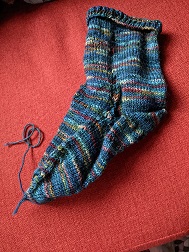On the slow, methodical progress of sweaters and stories.

My mother taught me to knit, considering it a life skill like reading and writing. A primary-school teacher, she also taught the kids in her classes knitting — right alongside reading, writing, and arithmetic. She made sure reading engaged and writing expressed, and she made arithmetic fun with cards and dice. Kids didn’t knit endless scarves but quicker, useful, finite projects like “cases” (woolen sacks, really) for their wooden soprano recorders.
She was a constant knitter, knitting whenever she was sitting still: during faculty meetings, on car trips, at or in all the vigils and lobbies and waiting rooms of life. She was creative, always revising or improvising patterns. She knitted intricate Norwegian sweaters (from patterns in a language she couldn’t read), argyle socks, and one-of-a kind grandkid vests with commissioned logos.
While downsizing my parents’ house for their move to assisted living — a little out of my mind, as we are at those times — I tossed her knitting patterns. It was too painful looking at those complex charts and graphs at a time when she still could move the needles but not remember or see beyond the moment. She looked up from the project I’d started for her (a useless scarf) to ask, “Why am I doing this?”
Good question, no answer.
Over the years, I was an episodic knitter, picking the practice and habit up, putting it down. I knitted sweaters, vests, ponchos — turning to Mom for advice and simple patterns. Sitting still, I’ve always been far more likely to have a book in my hand, or a pen, than knitting needles. I started knitting again in the doctors’ offices, the hospital rooms, of my parents’ final months. I finished a vest with a cable pattern, and put my needles down, after they died.
And I started writing fiction after a long, long break. I embarked on an MFA — knitting on the train en route to biannual residencies; knitting in lectures and at readings. I finished a couple of bulky sweaters, and my degree, and put my needles down again. I kept writing, though: stories, my first novel, more stories, another novel.
Mom taught all three of our kids to knit. My two daughters are her kind of knitters: intuitive naturals, capable both of following a complicated pattern and of improvising. My eldest is a constant, serial knitter. The habit came in handy on months-long sailing voyages, and she’s now the sort of knitter who can read and knit at the same time.
A year ago, she decided to move to Sweden. Suddenly, I felt compelled to learn to knit socks before she left. Small, useful socks. How hard could it be to learn with a home-grown tutor looking over my shoulder? Weekly, we knit in her apartment on Capitol Hill. I followed her instructions. Produced a lopsided pair of socks. Began another.
The pandemic delayed her move some months. Surely the extra coaching would give me time to master the mystical process of Turning the Heel, which requires concentration, confidence, and finesse. There is little room for error, though I found it. My feet aren’t a perfect pair, either, but these mismatched socks were failures. So, I gave up and began a sweater.
A sweater is much more forgiving than socks. One dropped stitch out of hundreds? A miscounted row? Just keep going. No need to stop and rip and start again. You’re in for the long haul — a marathon, not a sprint. Settle in and make it grow, day after day. Knit through the tough spots, be patient. Stick to it. Finish. Complete the final fiddle of weaving in loose ends. Block it, make it ready to wear.
Knitting, reading, and writing my way through these days, weeks, and months of pandemic, I’ve decided socks are more like poems or short stories, novels like sweaters. Faulkner said, “Maybe every novelist wants to write poetry first, finds he can’t, and then tries the short story, which is the most demanding form after poetry. And, failing at that, only then does he take up novel writing.”
Well, I’m no poet, and though I write short stories, in this oddly intense and tedious time, it’s been more natural, more possible, to continue the long-haul project of writing a novel than to capture the fleeting inspiration, the dream, of a short story. Almost every day, I write and print a few more pages. It helps, seeing the physical accretion of the draft, like seeing my sweater grow row by row.
These months, it feels like we’re standing still, waiting. My sweater-to-be, my novel-in-draft, give a sense of forward movement, purpose, incremental progress despite the continuing limbo. Word by word, stitch by stitch, I’m getting closer. To something.
Ellen Prentiss Campbell’s new collection of love stories is Known By Heart. Her story collection Contents Under Pressure was nominated for the National Book Award, and her debut novel, The Bowl with Gold Seams, won the Indy Excellence Award for Historical Fiction. Her novel Frieda’s Song will be published May 25, 2021. Her column, “Girl Writing,” appears in the Independent bi-monthly. For many years, Campbell practiced psychotherapy. She lives in Washington, DC, and is at work on another novel and a sweater.

